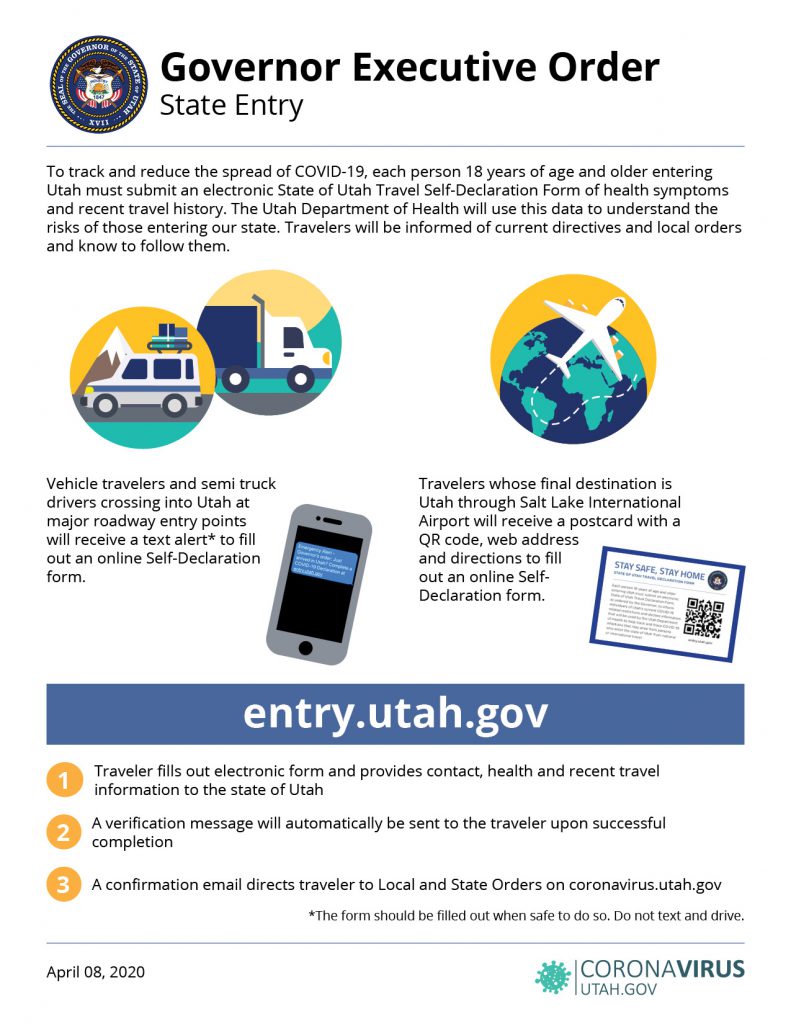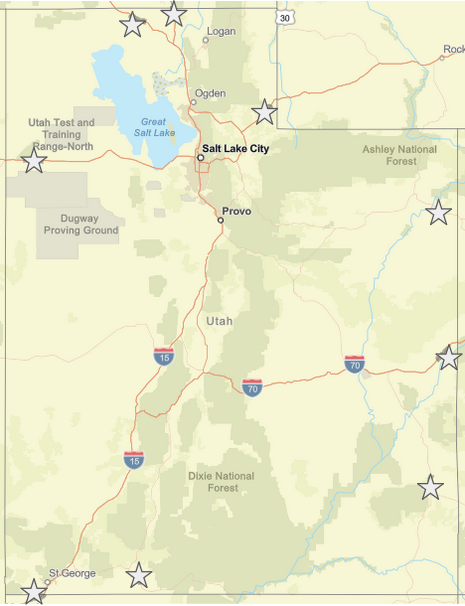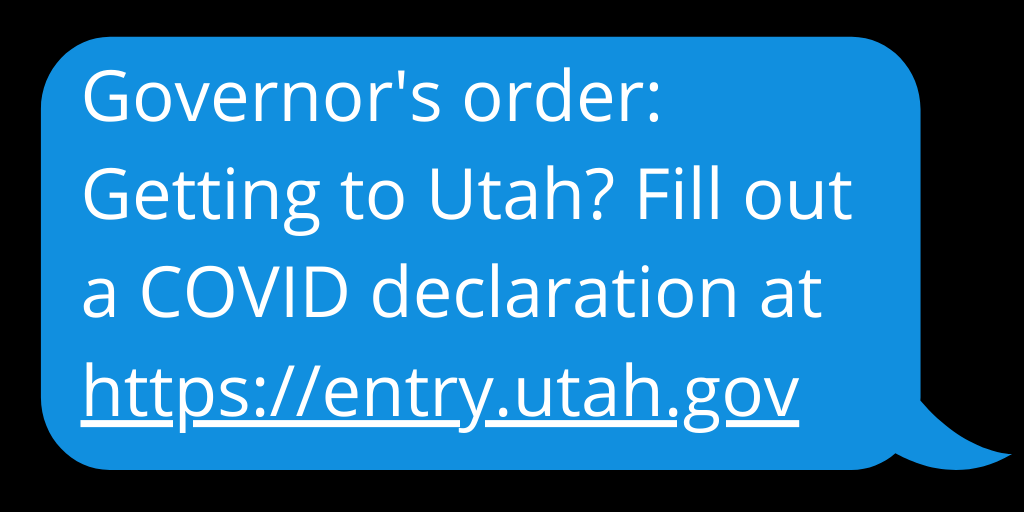THESE ALERTS HAVE BEEN DISCONTINUED. CLICK HERE FOR UPDATED INFORMATION ON THE UTAH TRAVELERS EXECUTIVE ORDER
This following out-of-date information will remain here since it is public information and we are maintaining a historical record. It also answers some of the questions that came up while this technology was in effect for this project.
Motorists entering near state borders will receive an alert that will direct them to fill out a health declaration, or form.
Did you receive the alert in an unexpected location, such as from home, or did you receive it multiple times in one day? Share your feedback in this quick survey to help us improve the accuracy of future alerts. The survey will no longer accept responses after April 13, 2020.
Following a recent executive order from Utah Gov. Gary Herbert, Utah will, for the first time, deploy a targeted wireless emergency alert (WEA) on certain highways that cross state borders into Utah. The alert will direct motorists to fill out a brief declaration, or survey, that is available at entry.utah.gov.
These are extraordinary times, and Utah is taking extraordinary measures like using this technology (which we have never used in an instance like this before). There may be some kinks here and there, but it’s absolutely essential to help us stop the spread of the coronavirus, COVID-19.
Jump to FAQs and known concerns
This is an effort to stay aware of people in Utah who might be at risk for spreading COVID-19. Passengers arriving at Salt Lake City International Airport will be directed to fill out the same survey before they leave the airport.

FAQs and known concerns
What areas are going to be alerted? See map below.
- I-15 at the Arizona border
- US-89 north of Kanab
- US-491/191 at Monticello
- I-70 at the Colorado border
- US-40 at the Colorado border
- I-80 at the Wyoming border
- I-15 at the Idaho border
- I-84 at the Idaho border
- I-80 at the Nevada border

Who will receive the alert?
The alert is intended to go to motorists that are crossing the border into Utah. Because the technology is not perfect, sometimes people who are miles away may receive the alert. People who receive the alert and have not recently crossed the border into Utah do not need to fill out the declaration form.
What will the alert say?
Governor’s order: Getting to Utah? Fill out a COVID Declaration at https://entry.utah.gov

How long will the alert be active?
The alert will become active at 12:30 p.m. on Friday, April 10, 2020, and will remain active until 11:59 p.m. on May 1, 2020.
What do I do if I receive the alert?
If you are a motorist, please fill out the declaration form the next time you stop. Do not fill it out while driving. That should only happen if a passenger can fill out the survey safely.
If you receive the alert and did not recently cross the border, you can ignore it.
Will I be stopped if I don’t fill out the declaration form?
If you are a motorist, you will not be stopped for failing to fill out the declaration form. But please follow our state laws and stay safe on our roadways.
What if I cross a state border every day for work?
We expect each motorist will fill out the declaration form one time. The alert system and your phone should work together to ensure that you receive the alert only one time. In some cases, phones may receive the alert multiple times. This is beyond our control.
How accurate is the targeting of these messages?
Unfortunately, we can’t separate inbound and outbound traffic, so motorists who are leaving the state will also receive the wireless emergency alert. Those motorists can ignore the alert until they return to Utah. But once you return, we expect you to fill out the declaration form at entry.utah.gov
Because the technology is not perfect, sometimes people who are miles away may receive the alert. We are asking your forgiveness because we are trying a new use of this technology to track a disease that has already killed 13 people in Utah and sickened many others.
What will the alert sound like?
Phones that are WEA-capable will make unique tones and vibrations that may be similar to the Emergency Alert System tests seen on TV. Depending on your phone’s settings or data activity, you may not hear a tone at all.
What is a Wireless Emergency Alert?
WEA is a technology that allows emergency managers to draw a shape on a map. Then, when a cell phone passes into that area, the system pings that cell phone and delivers a message.
How did you get my phone number?
The great thing about this technology is that we don’t have your phone number. There is no tracking through this type of alert, which is delivered using cell broadcast. This is different from a typical SMS or text message where the sender knows you received a message. The government receives no record of who ends up receiving a message through our system. The only confirmation we normally get is when people post screenshots of their messages on social media.
What good is it going to do?
The Utah Department of Transportation (UDOT) is collecting the data and will securely transfer that data to the Utah Department of Health (UDOH) for their awareness. Remember, coronavirus disease (COVID-19) is deadly. The data submitted through this program helps in our efforts to trace and mitigate the disease. We are able to inform travelers about public orders in Utah, and we are able to isolate incidents and notify anyone who may be affected.
You can learn more about keeping yourself and others safe at coronavirus-stage.at.utah.gov and by following UtahCoronavirus on Twitter and Facebook.
What if I don’t fill out the declaration form?
The governor’s executive order expects that people who receive the alert will be good public health citizens to help Utah slow the spread of COVID-19. There is currently no legal enforcement of the alert, however.
What if someone declares symptoms on the form or says they are infected with COVID-19? Will they be barred from entering the state?
If someone enters on their declaration that they are exhibiting symptoms, someone from the Utah’s tracing team will contact and get them quarantined. Having this information will help trace and mitigate the spread.
How will data be kept safe?
The State of Utah will store personal and health-related information collected from the declaration form in a secure environment and will limit who has access to the data. All personal and health-related information will be transferred to the Utah Department of Health for any needed follow-up. Summary information only will be compiled and no unique identifiers will be provided for any public reporting.
What are the ramifications to someone coming into the state? Can they be turned away if they are showing symptoms?
This is simply a data-gathering process. This executive order requires visitors to declare any COVID-19-related symptoms and recent travel information to the state. The goal is to track, trace and mitigate. This is not a complete picture but it’s complementary to other data collection systems.
What if I have been to more states during the last two weeks than the form allows space for?
Beginning with the most recent states you have visited, please list as many as the form allows you to list.
Why aren’t non-electronic methods of data collection being offered?
Paper forms will not be offered because they introduce the need for additional resources, methods of collection, and pose the risk of spreading COVID-19 as a result of handling and processing of forms and pencils.
What if I have questions?
For health-related questions about coronavirus, contact the Coronavirus Information Line at 1-800-456-7707.
For emotional relief and support, please call 1-833-442-2211.
Please also visit coronavirus-stage.at.utah.gov.
